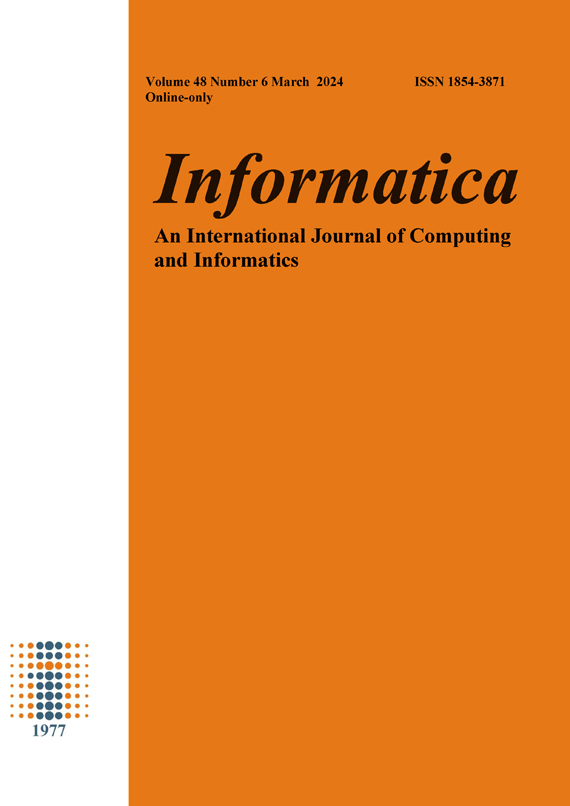Crime Prediction Using Twitter Sentiments and Crime Data
DOI:
https://doi.org/10.31449/inf.v48i6.4749Abstract
The incidence of crime is now of great concern globally. The culprits change their tactics on a regular basis. These crimes affect persons, groups, and the government to the extent a whole lot of budgets are allocated to serve as preventive measure to these crimes. The aim of this research is to predict crime based on Twitter hourly sentiments and crime data records. This is because it has been observed that existing crime prediction models that used Twitter data entail some drawbacks in predicting criminal incidents as a result of the unavailability of hourly sentiment polarity and demographic factors. Additionally, SHAP framework was used for the interpretability to rank the feature based on their importance. The xgboost algorithm was utilized with tuning to have an optimal model. The accuracy of 0.81 (81%) was obtained and an Area Under the Receiver Operating Curve (ROC AUC) score of 0.7079 was obtained. The result of this study indicated that crime could be predicted in real-time in contrast to earlier studies on this subject matter. Consequently, it is advised that this work be applied to real-world situationsReferences
ToppiReddy HKR, Saini B, Mahajan G. Crime Prediction & Monitoring Framework Based on Spatial Analysis. Procedia Comput Sci [Internet]. 2018;132(Iccids):696–705. Available from: https://doi.org/10.1016/j.procs.2018.05.075
Umair A, Sarfraz MS, Ahmad M, Habib U, Ullah MH, Mazzara M. Spatiotemporal Analysis of Web News Archives for Crime Prediction. Appl Sci. 2020;10.
Tompson L, Johnson S, Ashby M, Perkins C, Edwards P. UK open source crime data: Accuracy and possibilities for research. Cartogr Geogr Inf Sci. 2015;42(2):97–111.
Oladimeji OO, Oladimeji A, Oladimeji O. Classification models for likelihood prediction of diabetes at early stage using feature selection. Appl Comput Informatics. 2021;
Oladimeji OO, Oladimeji O. Predicting Survival of Heart Failure Patients Using Classification Algorithms. JITCE (Journal Inf Technol Comput Eng [Internet]. 2020 Sep 30;4(02):90–4. Available from: http://jitce.fti.unand.ac.id/index.php/JITCE/article/view/75
Malathi A, Baboo SS. Enhanced Algorithms to Identify Change in Crime Patterns. Int J Comb Optim Probl Informatics. 2011;2(3):32–8.
Brayne S, Christin A. Technologies of Crime Prediction: The Reception of Algorithms in Policing and Criminal Courts. Soc Probl. 2021;68(3):608–24.
Manzanares MCS, Diez JJR, Sánchez RM, Yáñez MJZ, Menéndez RC. Lifelong learning from sustainable education: An analysis with eye tracking and data mining techniques. Sustain. 2020;12(5).
Kotevska O, Kusne AG, Samarov D V., Lbath A, Battou A. Dynamic Network Model for Smart City Data-Loss Resilience Case Study: City-to-City Network for Crime Analytics. IEEE Access. 2017;5:20524–35.
Ahishakiye E, Omulo EO, Taremwa D, Niyonzima I. Crime prediction using Decision Tree (J48) classification algorithm. Int J Comput Inf Technol. 2017;06(03):188–95.
Nasridinov A, Ihm SY, Park YH. A decision tree-based classification model for crime prediction. Lect Notes Electr Eng. 2013;253 LNEE:531–8.
Iqbal R, Murad MAA, Mustapha A, Panahy PHS, Khanahmadliravi N. An experimental study of classification algorithms for crime prediction. Indian J Sci Technol. 2013;6(3):4219–25.
Chen X, Cho Y, Jang SY. Crime prediction using Twitter sentiment and weather. 2015 Syst Inf Eng Des Symp SIEDS 2015. 2015;(c):63–8.
Ohana B, Tierney B. Sentiment classification of reviews using SentiWordNet. 9th IT T Conf. 2009;
Mousa SR, Bakhit PR, Osman OA, Ishak S. A comparative analysis of tree-based ensemble methods for detecting imminent lane change maneuvers in connected vehicle environments. Transp Res Rec. 2018;2672(42):268–79.
Zhang X, Liu L, Lan M, Song G, Xiao L, Chen J. Interpretable machine learning models for crime prediction. Comput Environ Urban Syst [Internet]. 2022;94(November 2021):101789. Available from: https://doi.org/10.1016/j.compenvurbsys.2022.101789
Qi Z. The Text Classification of Theft Crime Based on TF-IDF and XGBoost Model. Proc 2020 IEEE Int Conf Artif Intell Comput Appl ICAICA 2020. 2020;1241–6.
Mitchell R, Frank E. Accelerating the XGBoost algorithm using GPU computing. PeerJ Comput Sci. 2017;2017(7).
Lundberg SM, Nair B, Vavilala MS, Horibe M, Eisses MJ, Adams T, et al. Explainable machine-learning predictions for the prevention of hypoxaemia during surgery. Nat Biomed Eng [Internet]. 2018;2(10):749–60. Available from: http://dx.doi.org/10.1038/s41551-018-0304-0
Sayres R, Taly A, Rahimy E, Blumer K, Coz D, Hammel N, et al. Using a Deep Learning Algorithm and Integrated Gradients Explanation to Assist Grading for Diabetic Retinopathy. Ophthalmology. 2019;126(4):552–64.
Putatunda S, Rama K. A comparative analysis of hyperopt as against other approaches for hyper-parameter optimization of XGBoost. ACM Int Conf Proceeding Ser. 2018;6–10.
Downloads
Published
Issue
Section
License
I assign to Informatica, An International Journal of Computing and Informatics ("Journal") the copyright in the manuscript identified above and any additional material (figures, tables, illustrations, software or other information intended for publication) submitted as part of or as a supplement to the manuscript ("Paper") in all forms and media throughout the world, in all languages, for the full term of copyright, effective when and if the article is accepted for publication. This transfer includes the right to reproduce and/or to distribute the Paper to other journals or digital libraries in electronic and online forms and systems.
I understand that I retain the rights to use the pre-prints, off-prints, accepted manuscript and published journal Paper for personal use, scholarly purposes and internal institutional use.
In certain cases, I can ask for retaining the publishing rights of the Paper. The Journal can permit or deny the request for publishing rights, to which I fully agree.
I declare that the submitted Paper is original, has been written by the stated authors and has not been published elsewhere nor is currently being considered for publication by any other journal and will not be submitted for such review while under review by this Journal. The Paper contains no material that violates proprietary rights of any other person or entity. I have obtained written permission from copyright owners for any excerpts from copyrighted works that are included and have credited the sources in my article. I have informed the co-author(s) of the terms of this publishing agreement.
Copyright © Slovenian Society Informatika








